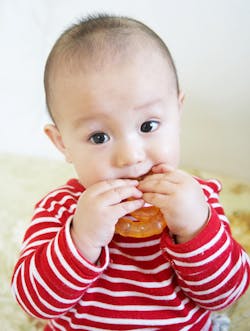The Hygiene Message in a Bottle Mailbag is a monthly feature of the e-newsletter, Pearls for Your Practice: The Product Navigator. Each month, Colleen Olson, RDH, BBA, the editorial director of the Hygiene Product Navigator, will answer reader-submitted questions to help you navigate your dental hygiene product decisions (and more!). This month, she shares recommendations for teething products for infants and toddlers.
What are the current recommendations for treating symptoms of teething in babies and toddlers?
Answer
Fantastic question! Most babies begin teething between 6 and 12 months. They continue getting primary teeth until about age three, and then things will plateau for a while until they start losing them to make way for permanent dentition. Some babies exhibit localized discomfort, decreased interest in eating, and increased irritability or fussiness just before and at the time of tooth eruption. Other babies show no signs of discomfort at all, and their teeth seem to magically appear without any apparent symptoms! If a baby has diarrhea, a fever, or a rash, the child should see a pediatrician; these are not normal signs of teething.
The American Academy of Pediatric Dentistry Guideline on Infant Oral Health Care suggests treating teething symptoms with oral analgesics and chilled teething rings. (1) The guideline discourages using topical anesthetics, including over-the-counter teething gels, because these products can be toxic to infants. (1) Products like Baby Orajel and Orabase are not recommended for infants because they contain benzocaine, which has shown an association with a rare but sometimes fatal condition called methemoglobinemia in which oxygen is no longer effectively delivered by the blood to the body tissues. (2)
Parents should also be advised to avoid homeopathic products. Over the past year, the FDA has issued multiple statements urging parents to discontinue use and dispose of Hyland’s homeopathic teething products because they were found to contain inconsistent and potentially harmful amounts of toxic belladonna. (3,4)
In sum, we should recommend that parents try nonmedicinal treatments first. A cool washcloth, a refrigerated plastic teething ring, or cold foods, such as chilled strawberries or cucumbers, may provide some relief to the teething baby’s gums. Over-the-counter pain relief medication, such as ibuprofen or acetaminophen, may also help if the child seems exceptionally bothered by tooth eruption. If symptoms persist longer than a few days, it’s likely that there is an issue other than teething, and the parent should consult the child’s pediatrician.
References
1. American Academy of Pediatric Dentistry Clinical Affairs Committee–Infant Oral Health Subcommittee. Guideline on Infant Oral Health Care. American Academy of Pediatric Dentistry Reference Manual. 2015–2016;37(6):146-150. http://www.aapd.org/media/policies_guidelines/g_infantoralhealthcare.pdf. Accessed March 14, 2017.
2. American Dental Association. Teething. MouthHealthy website. http://www.mouthhealthy.org/en/az-topics/t/teething. Accessed March 14, 2017.
3. FDA warns against the use of homeopathic teething tablets and gels [news release]. Silver Spring, MD: Food and Drug Administration; September 30, 2016. https://www.fda.gov/NewsEvents/Newsroom/PressAnnouncements/ucm523468.htm. Accessed March 14, 2017.
4. FDA confirms elevated levels of belladonna in certain homeopathic teething products [news release]. Silver Spring, MD: Food and Drug Administration; January 27, 2017. https://www.fda.gov/NewsEvents/Newsroom/PressAnnouncements/ucm538684.htm. Accessed March 14, 2017.
Editor's note: Do you have a question for Colleen? Is there a product you'd like to see her review? Or would you like to submit your own hygiene product article? Send an e-mail to pearlmail@pennwell.com. You might just see it in the Hygiene Product Navigator! If you're not a Product Navigator subscriber, click here to sign up.
More reading
March 2017 | Happy visits for patients under age 3
February 2017 | Electric toothbrush recommendations
January 2017 | New research on chlorhexidine as an irrigant for ultrasonic scaling









